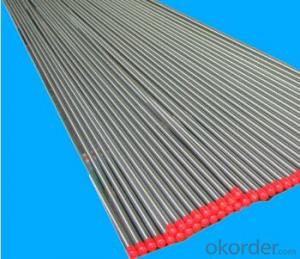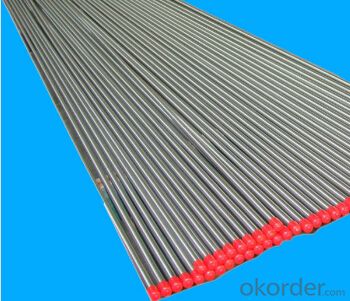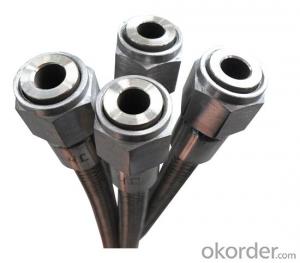seamless 2205 duplex stainless steel tube
- Loading Port:
- China Main Port
- Payment Terms:
- TT OR LC
- Min Order Qty:
- -
- Supply Capability:
- -
OKorder Service Pledge
OKorder Financial Service
You Might Also Like
Specifications
seamless 2205 duplex stainless steel tubeMaterial:304L,316L,316Ti,321,317L,310S,347H,904Letc.
Standard: A269, A213,
Cert:ISO
seamless 2205 duplex stainless steel tube
Material:304L,316L,316Ti,321,317L,310S,347H,904L, 321 stainless steel welded pipe etc.
Standar duplex steel d: A269, A213, A312 201 stainless steel round tube
1. Material | TP304/304L, 316/316L, 310S, 317L, 321, 347H,etc. |
S31803, 32750, etc. | |
2. Sandard | ASTM, ASME, DIN, EN, ISO,JIS, GOST, etc. |
3. Type | Seamless |
4. Size rangetube | OD: from 6mm to 1000mm (NPS from 1/8'' to 40'') |
WT: from 0.7mm to 38mm (Schedule from 5S to XXS) | |
Length: fix length or un-fix length, Max 30meters | |
5. Produce process | Pilgering and cold drawn |
6. Surface process | Pickling and annealing |
AP tube | |
BA tube | |
7. Marking | JW, GRADE, seamless, STANDARD, SIZE, HT NO. |
8. Package | Bundles with waterproof cloth outside. |
or plywood box. | |
9. Min order quantity | 500 KG |
10. Sample | Yes |
11. OEM accepted | Yes |
12. Production capacity | 300 tons per month |
13. Payment term | T/T or L/C. |
14. Certificate | ISO 9001, PED |
15. Third party ertificate | BV, LR, SGS, TUV, CCS, ABS, etc. |
- Q:What is the difference between 321 and 321H stainless steel pipes?
- The main difference between 321 and 321H stainless steel pipes lies in their carbon content and resulting mechanical properties. Both grades are stabilized austenitic stainless steels with titanium as the stabilizing element. However, 321H contains a higher carbon content compared to 321. The increased carbon content in 321H provides improved high-temperature strength and creep resistance. This makes 321H suitable for applications where elevated temperatures are involved, such as in the manufacturing of heat exchangers, furnace parts, and other high-temperature equipment. On the other hand, 321 stainless steel pipes are commonly used in applications that do not require exposure to high temperatures. They offer excellent resistance to intergranular corrosion and are frequently used in the aerospace industry, as well as for the fabrication of exhaust systems, chemical processing equipment, and other general-purpose applications. In summary, the difference between 321 and 321H stainless steel pipes lies in their carbon content and resulting mechanical properties. 321H is specifically designed for high-temperature applications, while 321 is suitable for general-purpose applications that do not require exposure to elevated temperatures.
- Q:What is the hardness of stainless steel pipes?
- The specific grade and treatment of the steel can cause variations in the hardness of stainless steel pipes. Stainless steel pipes exhibit a range of hardness levels, which are typically assessed using either the Rockwell scale or the Brinell scale. The hardness of stainless steel pipes surpasses that of other steel types due to the presence of alloying elements like chromium and nickel, which enhance resistance to corrosion and wear. Ordinarily, stainless steel pipes fall within the hardness range of 75 to 180 on the Rockwell scale or 150 to 300 on the Brinell scale. Nonetheless, it's worth noting that factors such as heat treatment, welding, and cold working processes can also affect the hardness.
- Q:How do you prevent stainless steel pipes from corroding?
- To prevent stainless steel pipes from corroding, there are several measures you can take: 1. Choose the right grade of stainless steel: Different grades of stainless steel have varying levels of corrosion resistance. It is important to select a grade that is suitable for the specific environment in which the pipes will be used. For more corrosive environments, higher grades such as 316 stainless steel are recommended. 2. Proper installation and maintenance: Ensure that the pipes are installed correctly, with appropriate gaskets, seals, and fittings to prevent any gaps or leaks that can allow moisture or corrosive substances to penetrate. Regularly inspect and maintain the pipes to identify and repair any damage or potential sources of corrosion. 3. Keep the pipes clean and dry: Regular cleaning of stainless steel pipes helps remove any contaminants or corrosive substances that may have accumulated. Avoid using harsh chemical cleaners that can damage the protective oxide layer on the surface of the stainless steel. Additionally, keeping the pipes dry by avoiding prolonged exposure to water or moisture can help prevent corrosion. 4. Apply protective coatings: Applying a protective coating or paint specifically designed for stainless steel can provide an additional layer of protection against corrosion. These coatings act as a barrier, preventing direct contact between the stainless steel and corrosive substances. 5. Cathodic protection: In certain cases where the pipes are exposed to highly corrosive environments, cathodic protection can be employed. This involves using sacrificial anodes or impressed current systems to protect the stainless steel from corrosion by diverting the electrical current away from the pipes. By following these preventive measures, you can significantly reduce the risk of corrosion in stainless steel pipes and prolong their lifespan.
- Q:Stainless steel pipe pickling ratio
- Usage: apply proper amount of this product onto the surface of stainless steel to be processed, the thickness of 1~2 mm, 5-30 minutes or longer (by dirt, sheet materials and processing requirements), process the best brush a few times, the surface oxide skin, rust completely clean, with water (lime water or salt water better) rinse, avoid rust.
- Q:Can stainless steel pipes be used for ornamental purposes?
- Stainless steel pipes possess the ability to serve ornamental functions. With its adaptability and contemporary allure, stainless steel emerges as the ideal material for embellishing purposes. Its resistance to corrosion and durability render it an exceptional choice for outdoor installations or environments with high humidity, where alternative metals may deteriorate over time. Stainless steel pipes can be shaped and sized in a multitude of ways, enabling the creation of imaginative and aesthetically pleasing designs. They find common application in architectural structures, such as railings, handrails, and balustrades, as well as decorative furniture, lighting fixtures, and artwork. Moreover, stainless steel pipes can be polished or finished in diverse manners to accentuate their appearance and achieve desired decorative effects. All in all, stainless steel pipes deliver a resilient and visually captivating solution for ornamental purposes.
- Q:Are stainless steel pipes suitable for wastewater pumping stations?
- Yes, stainless steel pipes are suitable for wastewater pumping stations. Stainless steel is a highly corrosion-resistant material, making it particularly well-suited for environments with high levels of moisture and chemicals, such as wastewater pumping stations. It is resistant to rust and can withstand the corrosive nature of wastewater, which can contain various chemicals and contaminants. Stainless steel pipes also have high strength and durability, enabling them to handle the pressure and flow requirements of wastewater pumping systems. Additionally, stainless steel pipes offer a smooth interior surface, which helps to minimize friction and improve the efficiency of water flow. Overall, stainless steel pipes are an excellent choice for wastewater pumping stations due to their corrosion resistance, strength, and durability.
- Q:Can stainless steel pipes be used for gas applications?
- Yes, stainless steel pipes can be used for gas applications. Stainless steel is highly resistant to corrosion and can withstand high temperatures, making it a suitable material for transporting gases. Additionally, stainless steel pipes have excellent strength and durability, ensuring the safety and reliability of the gas system. They are commonly used in industrial, commercial, and residential applications where gas is being transported. However, it is essential to ensure that the stainless steel pipes being used meet the specific requirements and standards for gas applications to ensure proper installation and performance.
- Q:What is stainless steel pipe?
- Stainless steel pipe is a type of pipe made from an alloy of steel and chromium, which provides excellent resistance to corrosion and oxidation. It is commonly used in various industries, including construction, automotive, and manufacturing, due to its durability, strength, and aesthetic appeal. Stainless steel pipes are known for their ability to withstand high temperatures and pressure, making them suitable for applications that involve transporting fluids and gases. Additionally, they are available in various sizes, shapes, and grades to meet specific requirements. Whether in residential or industrial settings, stainless steel pipes are widely used for plumbing, water supply systems, HVAC systems, and many other applications where durability and corrosion resistance are essential.
- Q:How is stainless steel pipe different from carbon steel pipe?
- Stainless steel pipe and carbon steel pipe differ mainly in their composition and corrosion resistance properties. Stainless steel pipe contains a higher percentage of chromium, which forms a passive oxide layer on its surface, making it highly resistant to corrosion and oxidation. On the other hand, carbon steel pipe does not have this protective layer, making it more prone to rust and corrosion. Additionally, stainless steel pipe is generally more expensive than carbon steel pipe due to its superior corrosion resistance and durability.
- Q:Can stainless steel pipes be used in the oil and gas industry?
- Stainless steel pipes are indeed suitable for use in the oil and gas industry. They come with several advantages that make them highly desirable for this sector. Firstly, their exceptional resistance to corrosion is of utmost importance in withstanding the harsh environments and corrosive substances found in the oil and gas industry. This corrosion resistance ultimately prevents leaks and ensures the pipes' integrity, leading to enhanced safety and reliability. Moreover, stainless steel pipes boast remarkable strength and durability, enabling them to endure the high pressures and temperatures frequently encountered in oil and gas operations. Additionally, stainless steel is non-reactive, meaning it does not contaminate the oil or gas being transported, thereby guaranteeing the purity and quality of the product. In summary, the superior properties of stainless steel render it the preferred choice for oil and gas industry applications, providing a dependable and long-lasting solution.
1. Manufacturer Overview |
|
|---|---|
| Location | |
| Year Established | |
| Annual Output Value | |
| Main Markets | |
| Company Certifications | |
2. Manufacturer Certificates |
|
|---|---|
| a) Certification Name | |
| Range | |
| Reference | |
| Validity Period | |
3. Manufacturer Capability |
|
|---|---|
| a)Trade Capacity | |
| Nearest Port | |
| Export Percentage | |
| No.of Employees in Trade Department | |
| Language Spoken: | |
| b)Factory Information | |
| Factory Size: | |
| No. of Production Lines | |
| Contract Manufacturing | |
| Product Price Range | |
Send your message to us
seamless 2205 duplex stainless steel tube
- Loading Port:
- China Main Port
- Payment Terms:
- TT OR LC
- Min Order Qty:
- -
- Supply Capability:
- -
OKorder Service Pledge
OKorder Financial Service
Similar products
New products
Hot products
Hot Searches
Related keywords





























